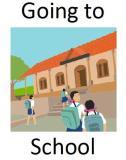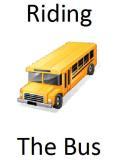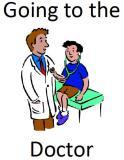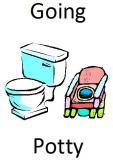Free Social Stories -
Printable PDF for Children
Download free social stories for children with autism symptoms or pervasive developmental disorders (PDD) to help with anxiety so they know what to expect and/or understand a certain situation, skill or concept. Although, they were originally designed to be used for individuals with autistic disorder, social stories have proven to be valuable when used with all children and adolescents with social and communication delays, as well as kids developing normally. They can be made in the form of a book or a video used for just about any event and are easily applied alone or along with picture exchange communication systems (PECS). You can learn how to write your own or use the free social stories below that I have created!
When I first started working in the field of applied behavior analysis (ABA), these were not something that were commonly used during therapy. However, as I learned additional methods to use and apply for children with autism, I discovered how valuable these could be in the form of desensitization for kids. When applying a desensitization program in ABA you allow them to come into contact with small amounts of objects related to the event and provide reinforcement in the form of praise or a small edible for remaining calm during the exposure. For example, you might simply start by showing them scissors or clippers used to cut hair.
They would see them and get reinforcement for remaining calm while a therapist counts 1, 2, 3 etc. working up to as much as 5-10 minutes without any visible reaction and moving onto having the clippers touch their head (while off). Sometimes this method isn't always easily applied if the event can't be easily recreated in a controlled environment or if the objects (stimuli) is too aversive causing a reaction. This is when using a social story would be very helpful. A picture of related items, such as the scissors and clippers would be less provoking and allow one the ability to give reinforcement when the child allows the story to be read and is willing to look at the pictures of the items without a visible reaction. As a result, this strategy can easily be incorporated into any ABA program for desensitization.
You will need adobe reader to download. A link to download this is available below.
You will need Adobe Reader (the latest version is recommended) installed on your computer in order to open the free social stories. You can get Adobe Reader here (a new window will open so you can download it without leaving this page, but you will need to temporarily disable any pop up blockers to open the new window). Fill out the form in order to receive all of the following free social stories.
 |
 |
 |
 |
Creating Social Stories with Pictures
Although the free social stories for children shown above work well to give ideas, it is best to try and make your own with real pictures to help your child relate better. If you are able to take your camera and get real pictures of your child’s school, bus, local grocery store etc. this will make the story that much more effective.
Once you have acquired all of the necessary pictures, you can find an app to use or assemble them into a story yourself. Instructions on how to do this can be found at the link above. Some apps are free to use and let you add your own pictures and captions. Then it puts the pages together, so that you can scroll through it to read. The Model Me Kids app has additional free social stories that are great for kids. However, creating your own with your child. as the main character in the story is SO powerful for a child. You can even just put them in order in a photo album on your phone and scroll through the pictures narrating what is happening without there even being words on a page! The exciting part about this is the story can change slightly every time to make it even more fun for your child.
You may also consider purchasing the book below. Carol Gray founded this concept in 1971 and her book offers over 150 different options to read. It can be a simple way to get started using this amazing strategy!
Free Social Stories for Potty Training

One child, I used to work with, adamantly refused when her mother tried potty training bowel movements. Her mother created a social story with pictures of her about coming home from school, eating dinner, playing with toys, sitting on the toilet and having a bowel movement (stating how good it feels to go on the toilet), taking a bath and then getting ready for bed.
This was her typical routine each day, but usually the bowel movement was completed in a diaper that she requested to wear each day when she needed to go. She would read this to her daughter every day. Her mother also would say things such as “Poop, goes in the potty.” while putting all bowel movements in the toilet from the diaper as well.
Using only these three interventions, within about 1-2 months, her daughter one day just went and sat on the toilet and had a bowel movement. She then began going on the toilet regularly, which makes using social stories great for potty training resistance.
Her mother had previously tried reinforcement plans, constant asking, pleading, and mild reprimanding for going in her diaper, without even so much as an attempt on the toilet. She even promised to let her pick out her favorite Barbie (a huge reinforcer). So, although this may be time consuming to create, the benefits are definitely worth it.